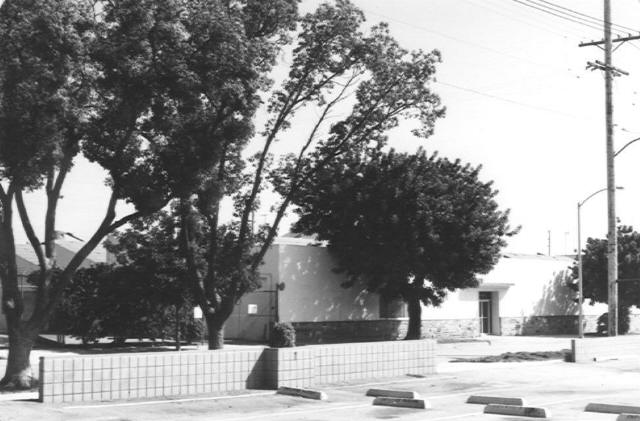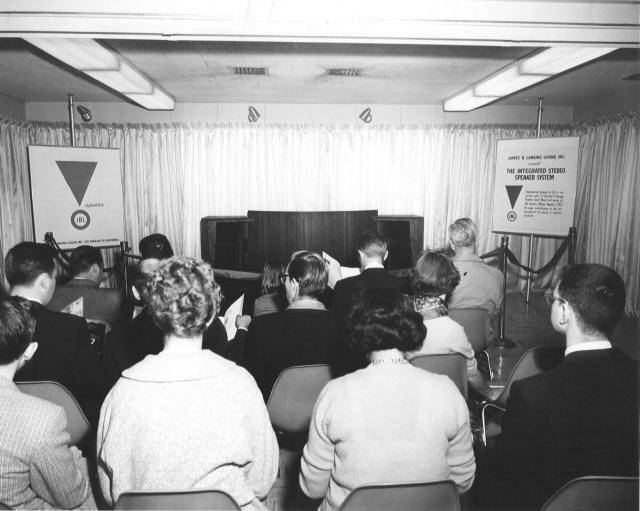|
|
|||||||||||

|
|
||||||||||
The paragon
|
|||||||||||
|
Returning to his Berkeley home with a set of engineering drawings of the prototype, Wolf began work on the Paragon in the early spring of 1957. By August he was ready to present his design to JBL. An interesting and little-known complication in the assignment rested on Thomas's and Pepe's belief that, to sell the concept to the public, the dramatic enclosure would have to be placed in nearly every franchised dealer's showroom. The investment in the cabinetry was intimidating by itself, but if each display piece was also loaded with transducers then the cost of inventory might be prohibitive. Accordingly, Wolf was directed to come up with a "shell" design for the enclosure that would permit the insertion (from the back) of basic plywood acoustical enclosures finished in utility black that would carry the transducer elements. While Wolf proceeded with the design on this basis, it was soon realized that the loading of the active system elements on an "as needed" basis was both cumbersome and ill-advised, because it became evident that a sonic demonstration in the showroom was even more essential than the visual presentation. A further requirement of the structural design was that it be readily knocked down into three parts -- the left and right channel enclosures and the curved radiator panel -- to simplify packaging for shipment and to reduce transportation costs. This consideration also meant that the system had to be capable of foolproof reassembly by the dealer using only the most common tools. As the design evolved, Wolf felt that typical working drawings and perspective renderings would not adequately convey the subtleties of the piece. He elected, therefore, to present the concept in the form of a scale model that would also demonstrate the disassembly/assembly procedure. The scale of one inch to the foot was selected for the practical reason that the model would then fit into a protective shoebox which, in turn, would fit into a Gladstone-type bag – the only piece of luggage that Wolf owned at the time.
JBL had moved to the Casitas Avenue location by the time Wolf arrived to show the Paragon design. He remembers being ushered into Ray Pepe's office, carrying the piece of luggage. Seeing no rolled-up drawings or large illustration boards, Mr. Pepe asked where the design was. "In here," replied the designer, indicating the travel bag. Pepe was understandably incredulous. "Well, let's see it," replied the marketing man. After Wolf took the model out of its wrappings he placed it on top of Pepe's desk. Wolf became alarmed when Pepe said nothing at all; instead, he dropped to his knees to view the model at eye level and then proceeded to rotate it to give himself various viewpoints. At length, he got up, resumed his chair, and picked up the phone. "Bill," he said, "you've got to get in here." Bill Thomas was there in a moment and, after further reviewing the design, both men expressed their enthusiasm for the concept.
After some later discussion with the Engineering and Furniture Factory personnel, work was immediately begun on translating the design into a producible product. A basic dimensional drawing was prepared in Berkeley, with particular attention being paid to the cross-sectional development of the sculptured solid walnut legs. Interestingly enough, the only element of the initial design that needed to be changed was the leg. Originally drawn as a one-piece carving, this approach would have required a left- and right-hand version because a slot on the back of the top section was designed to receive the leading edge of the exposed horn. An additional problem was the extreme difficulty, due to tolerance variations, of making a perfect join between the horn edge and the associated recess in the leg. It was decided, therefore, to make each leg in two pieces, with the top section capable of being rotated with reference to the fixed lower section. In actual production, the legs were made of gunstock walnut carved on automatic "follower" lathes on which a handmade sample serves as a pattern. The curved refractor panel presented some manufacturing problems as well; however, all these difficulties were overcome in time to start producing the Paragon by the end of 1957.
©2000 Arnold Wolf
|
|||||||||||













